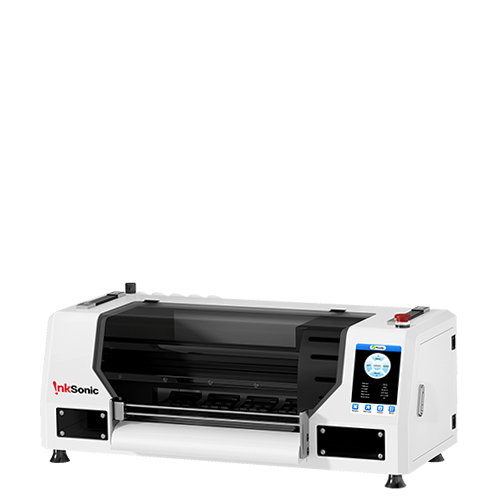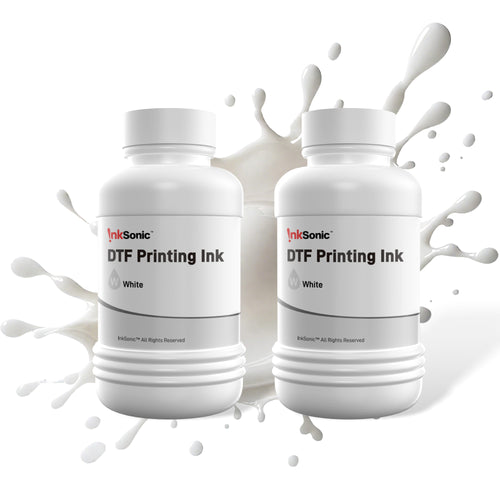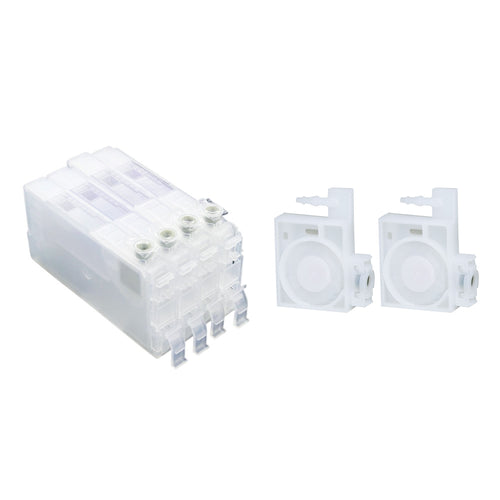DTF printing has quickly become a favorite among custom apparel creators for its vibrant results and versatility across fabrics. But how much does it really cost to print each shirt? The answer isn’t one-size-fits-all. From ink and film to design complexity and order size, several factors shape your final price. In this guide, we’ll break down every cost component—so you can plan smarter, price better, and protect your profit margins.
How does it stack up against other printing methods?
In today’s world, where so many custom printing methods exist (DTF, sublimation, screen printing, DTG, etc.), it can be hard to pin down what makes the most financial sense for you and your business.
DTF printing has been gaining ground because of its fabric versatility, vivid color results, and relatively low startup cost. Let’s take a closer look at how it stacks up against two other popular methods: sublimation and screen printing .
Method |
Avg. Cost per Shirt |
Best For |
Fabric Compatibility |
Setup Requirements |
Minimum Order? |
DTF Printing |
$2.00 – $6.00 |
All-around apparel, full-color prints on all fabrics |
Cotton, blends, polyester, dark & light fabrics |
Mid-level: printer, film, powder, heat press |
No — great for one-offs |
Sublimation |
$1.00 – $3.00 |
High-quality prints on white polyester |
White/light-colored polyester only |
Low: sublimation printer, paper, heat press |
No — but fabric limited |
Screen Printing |
$1.50 – $3.00 (bulk only) |
Large runs of simple designs (logos, team tees) |
Cotton, blends, polyester (limited on darks) |
High: screens, setup per color |
Yes — usually 50+ per design |
DTF is right in the middle—affordable enough for small business owners, yet able and powerful enough for professionals. While other methods excel in particular niches, DTF has the ideal mix of affordability, quality, and ability.
What Affects the Price of DTF Printing?
The cost of DTF printing for a single T-shirt will also depend on the applied consumables, including DTF printer ink, DTF printing film, and powder. The complexity of the design and number of your order can also affect the final per-shirt cost.
1. DTF Printing Ink and DTF Transfer Paper Costs
The film and ink are two primary components used in DTF printing. The DTF printing film is also called DTF transfer paper, it is the medium where the design is printed before it’s transferred to the T-shirt. Meanwhile, the ink used in this type of printing works on various fabrics.
The costs of these materials affect the price per shirt. High-quality DTF printer inks and DTF printer film produce better print quality but may come at a higher cost.
If your design requires multiple colors, you’ll use more DTF printer ink, which can increase the DTF printing costs. Depending on the size and design detail, the ink price per T-shirt is between $0.60 and $1.00.
DTF printing film roll can create several hundred prints depending on the design size. For an average-size print on a T-shirt, the range price is between $0.30 and $0.50 per shirt.
2. DTF TPU Powder and Adhesive Costs
The DTF powder is the other necessary medium for DTF printing which helps the DTF printer ink adhere to the garment during the transfer.
Although the cost of DTF printer powder per T-shirt is minimal, about $0.10 to $0.20, it is crucial to use high-quality powder, especially if you plan to sell the shirts. That way, the prints can last and withstand regular washing.

The Impact of Design Detail on Cost
Besides the tools and consumables, the complexity of the design can affect the direct-to-film printing cost. Simple designs are cheaper and faster to produce. Meanwhile, intricate designs are more expensive and may result in slower production.
1. Simple vs. Complex Designs
A simple, single-color or text design is the most affordable option. It uses less DTF printer ink and DTF paper, resulting in a lower cost of DTF printing per T-shirt, approximately $1.50 to $2.50. On the other hand, complex, detailed designs with multiple colors or gradient accents will cost more. The price range can reach up to $3.00 per shirt since these layouts need more ink and film.

2. Full-color prints and Photographic Images
If your design includes full-color prints and photographic images, expect the DTF printing cost per square inch to be higher. These layouts require a broader spectrum of DTF printer inks and precise application, which is labor-intensive. The DTF printing cost per shirt ranges between $3.50 and $5.00 for these intricately detailed designs.

3. DTF Printing on Large Print Areas
The DTF print area size also affects the charges. A small chest logo is more affordable than a large, full-front or back design. Large print areas need more inks, film, and powder, driving up the cost. Thus, expect to pay an additional $1.00 to $3.00 per shirt if the logo is large.
How Design Adjustments Saved Money
When Chris, the owner of a small streetwear brand in Atlanta, first started using his DTF printer, he was spending over $4 per shirt due to highly detailed, full-color graphics on every design. While the prints looked amazing, the ink usage was sky-high , especially for heavy white underbases and gradient effects.
“I loved how sharp my prints looked,” Chris recalls, “but I didn’t realize that all those textures and fades were eating up ink fast.”

After tracking his print costs for a month, Chris decided to simplify his designs without losing the brand's visual appeal . He reduced unnecessary white ink layers, minimized oversized prints, and reworked a few graphics to use bolder colors with less shading.
"By discovering how design complexity affects the use of ink, I cut 20% from my costs without compromising print quality."
Streamlining print and artwork size, Chris dropped his cost per shirt down to around $3.5, while keeping his selling price at $28. With a $25+ margin per shirt and more efficiency, he doubled output and now sells over 150 units each month, mostly via Instagram and pop-ups locally.
The Effect of Batch Size on DTF Printing Cost
How many Tshirt do you order per batch can make the DTF printing cost per Tshirt different. Bulk orders are usually cheaper because of economies of scale. Small orders or individual prints, meanwhile, usually cost more.

1. Economies of Scale in DTF Printing
When you place a bulk order for T-shirts, the price per unit decreases. The reason is that the setup time—which includes loading the design, preparing the film, and heating the press—is the same as printing a shirt or a hundred volume. Therefore, spreading these setup costs over a bulk of T-shirts cuts down the price per clothing. For instance, printing 100 shirts can cost around $2.50 per T-shirt, but if you order 500 shirts, the price can be as low as $2.00 per shirt.
2. Customization and Individual Orders
Individual, custom designs are the most expensive among the three. This order requires separate setups for each item, adding time and expenses. Custom one-off layouts can cost around $7.00 to $10.00 per shirt, depending on the detail and size of the print.
3. Small Batch Printing Cost
On the flip side, with smaller orders, the DTF printing costs will be more expensive per shirt, because the setup costs are divided among fewer items. And some printers may charge premium rates for smaller runs because they do not receive the same bulk discounts on materials. So, for let’s say ten or less, the price may go between $4.00 and $6.00 per T-shirt.
Hidden Charges and Additional Considerations
Ink, film and powder are just the major components to direct-to-film printing cost, taxes and the price of the blank T-shirt can also factor into the cost.
1. DTF Printer Taxes and Import Fees
Depending on your location, add taxes and import fees to the DTF printing costs, especially if you’re ordering from an international supplier. These fees can add 5% to 20% to your total expenses. Check with your supplier or local customs office for any applicable charges.
2. Price of Blank T-Shirts
The cost of a blank shirt is a crucial point of the overall cost. A blank T-shirt costs between $2.00 and $10.00 each, depending on the brand, quality, and fabric. Choosing higher-quality shirts is costly but leads to better printing results, making it a wise choice if you plan to sell them.

3.Maintenance Costs
While material costs constitute a large part of DTF printing, remember to also budget for ongoing maintenance. Cleaning fluids, new waste tanks, and occasional part replacement keep your printer in top operating condition and prevent costly downtime. The typical small business user can anticipate spending $10 to $20 a month on maintenance—well worth the cost for high-quality prints and long machine life. Missing this step can lead to clogs or inconsistent prints, which is more expensive in the long term.
Cost vs. Profit: How Much Can You Really Make with DTF Printing?
Understanding the cost is half of the equation—most important is how much you can sell for. DTF printing may take a bit more investment up front, but the profit margin is where it truly shines, especially for small businesses or artists selling direct-to-consumer.
Scaling that up to include hoodies, tote bags, or custom client work. The margins grow quickly—and with DTF’s low cost per print and material versatility, it’s a business model with real potential.

Product Type |
Avg. Cost to Produce |
Selling Price |
Estimated Gross Profit per Item |
Monthly Volume |
Monthly Gross Profit |
Basic T-shirt |
$3.50 |
$25.00 |
$21.50 |
100 |
$2,150 |
Premium Hoodie |
$6.00 |
$40.00 |
$34.00 |
50 |
$1,700 |
Tote Bag |
$2.80 |
$18.00 |
$15.20 |
120 |
$1,824 |
Small Batch Orders (Custom 1-offs) |
$5.00 |
$30.00 |
$25.00 |
20 |
$500 |
Not much of that profitable with a quite average amount of sales even. It doesn’t matter if you’re just getting started or taking a merch brand to the next level, knowing where you are at cost to profit wise enables you to price your gear smartly and it sets you up for a scalable business model.
Outsourcing vs. In House DTF Printing: Which is Better for You?
If you are launching a local custom apparel business or expanding an existing business, you will sooner or later come to this burning question: Invest in your own DTF printer or stick to the old path to outsource the prints?
When you factor in repeat business, design flexibility and longer-term profitability, in-house DTF printing is often the winner for smaller to medium-sized garment brands.
Let’s break it down.
Factor |
In-House DTF Printing |
Outsourcing Printing |
Cost per Shirt |
$2.50 – $5.00 |
$8.00 – $15.00 |
Upfront Investment |
$1,500 – $4,000 (printer, consumables, accessories) |
None |
Turnaround Time |
Same-day to 1–2 days |
5–10 business days (or longer during peak seasons) |
Design Flexibility |
Unlimited—print 1 or 100 of any design |
Limited—changes may incur extra charges |
Customization Ability |
High—great for one-offs, personalized items |
Lower—usually requires minimum order quantities (MOQs) |
Quality Control |
Full control over materials, print quality, and color |
Risk of inconsistencies; limited control over ink, shirt, etc. |
Scalability |
Medium to High (more profit as order volume grows) |
Easy to start, but expensive to scale |
Ideal For |
Brands seeking control, high margins, fast turnaround |
Beginners, one-time projects, or small test batches |
Compare the Profits
Suppose you're selling a shirt for $25:
-
Outsourced printing cost : ~$10 per shirt → $15 profit
In-house DTF printing cost : ~$3.50 per shirt → $21.50 profit
At 100 shirts per month, that’s $2,150 in-house profit versus $1,500 when you outsource — a $650 margin every month. That’s an additional $8,000 a year in profit — enough to purchase an extra printer or expand your offering.
If you’re serious about growing, investing in your own DTF system gets you long-term savings, brand consistency and creative freedom
How to Cut the DTF Printing Costs
Now that you know how much DTF printing costs, you surely want to find out how to reduce expenses. There are several ways to reduce the cost of DTF printing per T-shirt. Following the tips below can help you manage your budget effectively.
1. Opt for Simpler Designs
One of the easiest ways to reduce the direct-to-film printing cost is by choosing simple designs. The simpler the layout, the fewer resources it requires; hence, less money to spend. This approach is cost-effective, especially if you plan to produce or buy larger orders for a large event or giveaway.
2. Buy in Bulk
As mentioned earlier, bulk ordering will make the cost of DTF printing per T-shirt lower. If you're in the apparel business and need more shirts to sell in the future, order in bulk initially. Apart from saving on money, it also gives you some extra stock to reduce the demand for small and costly reorders.

3. Choose Economical Blank T-Shirts
While we suggest utilizing higher-quality shirts, purchasing a high-priced material is not necessary unless the project calls for it. Standard cotton shirts work in most uses and are less expensive. Costs can be reduced with good-quality clothing without sacrificing quality by balancing quality and price.
Most Common Mistakes That Raise DTF Printing Expenses (And How to Prevent Them)
While DTF is one of the least expensive methods of decorating garments, little errors in every step of the process can add up over time to a really big cost. From wasted film to machine downtime, these preventable errors can erode your bottom line and hold up production.
Here are the most common mistakes that increase DTF printing costs—plus how to prevent them before they hurt your bottom line.
Mistake |
Why It’s Costly |
How to Avoid It |
Overusing White Ink |
Excess white ink increases per-print cost and can cause nozzle clogs over time. |
Adjust RIP software settings to apply only the necessary white layer. |
Poor Print Alignment |
Misaligned prints = wasted film, wasted ink, and unusable transfers. |
Use alignment guides or templates and double-check positioning. |
Low-Quality Blank Shirts |
Cheap shirts may bleed, distort, or shrink after pressing, leading to reprints. |
Choose consistent mid- to high-quality blanks with proven print results. |
Neglecting Printer Maintenance |
Ink clogs or hardware failures result in downtime, wasted film, and costly repairs. |
Perform routine cleaning and keep white ink circulating or shaken daily. |
Incorrect Heat Press Settings |
Overheating or under-heating causes peeling, cracking, or poor adhesion. |
Follow exact temperature/time/pressure settings for DTF transfers. |
Not Testing New Designs First |
Jumping straight to full runs risks bulk errors if the color or size is wrong. |
Print a single test transfer on scrap fabric before large runs. |
Quick Fixes That Save You Money
-
Use a nozzle check before every print session to avoid printing with clogged heads.
Buy test rolls or sample packs before committing to bulk orders of film or powder.
Log your failed prints to track patterns and reduce recurring mistakes.
In DTF printing, consistency is key. A few small habits—like checking alignment, dialing in white ink settings, and keeping your printer clean—can save you hundreds of dollars in wasted materials over time.
Ink Bear Final Thoughts
Having the determinants of the cost of DTF printing for each T-shirt will be able to lead you in making wise choices to pay for your expenses. All these variables add up to the overall direct-to-film printing cost, from consumable costs to design complexity and batch size.
Also, being aware of the hidden costs and working to reduce the expense of DTF printing will help you stay within your means while still achieving top-notch output. Whether you're doing T-shirt print for private or business use or have a huge event to plan, all these factors and tips will help you get the best out of your investment.
Whether you're starting out or growing, quality supplies can be the make-or-break point. From premium-grade DTF inks to transfer film and powder that won't let you down, every component impacts your bottom line. Require professional advice from someone who knows what you can afford and what you're trying to achieve? Contact us today for a free consultation —we can assist you in printing smarter, not cheaper.

































